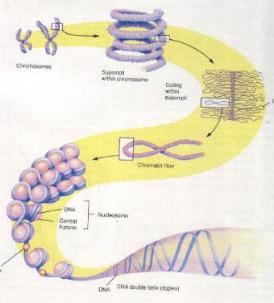6. The Genetics
The science behind Tourette's Syndrome is quite complicated
and much research is still being done to ascertain its causes and possible
methods of curing those affected by it. So far the disease has been
characterised as a genetic disorder. This section is designed to give a brief
but scientific understanding of genetics in relation to
Tourette's Syndrome. It all begins with the genetic make
up of an individual. Genes combined with the environment make us what we are.
Together they affect our height, shape, colourings and many many other features
that make us what we are.
Diagram Reference:
http://au.geocities.com/jones_kacm/
 Genes
are sections of a huge molecule called DNA. To the left is a diagram showing how
DNA molecules, "the building blocks of life" arrange themselves in
almost every cell of
an organism. The structure resembling an X in the diagram is a chromosome. It is
comprised of DNA which is wrapped around itself in a helix and then wrapped
around proteins called histones. Each gene will code for a particular trait
within an organism. Each gene consists of two alleles. It is these alleles which
are important in Tourette's Syndrome.
Genes
are sections of a huge molecule called DNA. To the left is a diagram showing how
DNA molecules, "the building blocks of life" arrange themselves in
almost every cell of
an organism. The structure resembling an X in the diagram is a chromosome. It is
comprised of DNA which is wrapped around itself in a helix and then wrapped
around proteins called histones. Each gene will code for a particular trait
within an organism. Each gene consists of two alleles. It is these alleles which
are important in Tourette's Syndrome.
In most cases alleles are dominant or recessive compared to
their partner allele. This can be represented as an upper (a dominant allele)
or a lower (a recessive allele) case letter. It is now necessary to define two
words. The phenotype and the genotype. The phenotype is a physical trait which
an organism has. This is determined predominantly by its genotype. The genotype consists of
the two alleles. In simple cases where only one gene governs a particular
phenotype, only three genotypes are possible. Here the letters B and b will
be used to represent the dominant and recessive alleles respectively. The
possible genotypes are BB, Bb or bb. In an organism, it is normally the case
that the dominant allele (if present) will be expressed in the phenotype. If
only recessive alleles are present, then the phenotype of the recessive allele
will be expressed.
Tourette's Syndrome is governed mainly by one gene
which here shall be denoted as A or a representing the dominance
of the alleles. So the
possible combinations are AA, Aa or aa.
Tourette's Syndrome is said to be semi-dominant. This means that the presence
of the dominant allele makes it likely, but not certain, that an individual will
have Tourette's syndrome.
The reason for this arises due to the A gene being responsible for a
variety of diseases. These are: Tourette's Syndrome (TS) Obsessive Compulsive
Disorder (OCD) and Chronic Tic Disorder (CTD). Thus, if you have the A allele,
you can be affected by TS, OCD or CTD. It also means a parent with OCD can give
birth to a Tourette's child, or visa versa. So having the A allele does
not necessarily mean that one will have Tourette's Syndrome.
 Genes
are sections of a huge molecule called DNA. To the left is a diagram showing how
DNA molecules, "the building blocks of life" arrange themselves in
almost every cell of
an organism. The structure resembling an X in the diagram is a chromosome. It is
comprised of DNA which is wrapped around itself in a helix and then wrapped
around proteins called histones. Each gene will code for a particular trait
within an organism. Each gene consists of two alleles. It is these alleles which
are important in Tourette's Syndrome.
Genes
are sections of a huge molecule called DNA. To the left is a diagram showing how
DNA molecules, "the building blocks of life" arrange themselves in
almost every cell of
an organism. The structure resembling an X in the diagram is a chromosome. It is
comprised of DNA which is wrapped around itself in a helix and then wrapped
around proteins called histones. Each gene will code for a particular trait
within an organism. Each gene consists of two alleles. It is these alleles which
are important in Tourette's Syndrome.